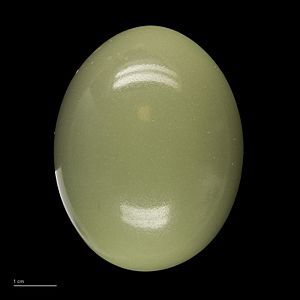Elegant crested tinamou facts for kids
Quick facts for kids Elegant crested tinamou |
|
|---|---|
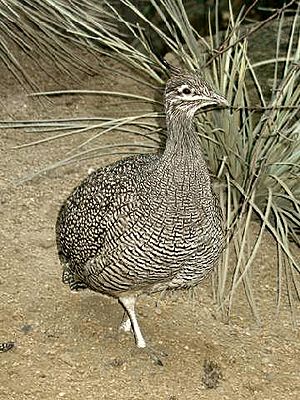 |
|
| At the Bronx Zoo, New York City | |
| Conservation status | |
| Scientific classification | |
| Genus: |
Eudromia
|
| Species: |
elegans
|
| Subspecies | |
|
E. e. elegans(Saint-Hilaire, 1832) |
|
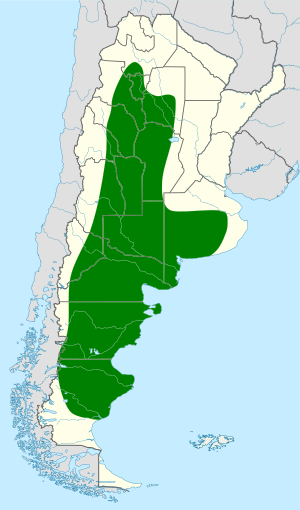 |
|
| Synonyms | |
|
|
The elegant crested tinamou (scientific name: Eudromia elegans) is a bird found in southern Chile and Argentina. It lives in areas with bushes and open spaces. This bird is known for its unique crest and its habit of running instead of flying.
Contents
What is an Elegant Crested Tinamou?
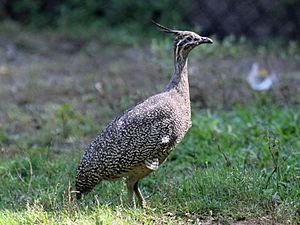
The elegant crested tinamou looks a bit like a partridge. It has a rounded body and wings. Its feathers are mostly olive-brown with black and white patterns. A long, off-white stripe runs from above its eye down its neck.
This bird has a short beak that points upwards. Its legs and feet are short and strong, perfect for running. They are whitish-grey in color. An adult tinamou is about 39 to 41 cm (15–16 inches) long. You can often spot them in groups of 5 to 10 birds. They make a whistling sound that helps people find them.
Where Do They Live?
Elegant crested tinamous prefer open areas. They do not like very tall grass or thick bushes. You can find them in dry grasslands, open areas with scattered bushes, dry savannas, and even on farms.
These birds live at many different heights. They can be found from sea level all the way up to 2,500 meters (8,200 feet) high. Their home is across Argentina and Chile.
What Do They Eat?
The elegant crested tinamou is an omnivore, meaning it eats both plants and animals. What they eat changes with the seasons. In winter, they mostly eat plant parts like grains, fruits, leaves, and buds.
However, in summer, they eat a lot of insects. When looking for food, they travel long distances. But if there is plenty of food in one spot, they will stay there.
How Do They Behave?
These tinamous spend most of their time on the ground. They run and walk a lot, unlike many other birds. At night, they sleep in regular spots called roost-sites.
To keep clean, they take dust baths. This helps them remove tiny parasites from their feathers. If they sense danger, they become very careful. An alarmed tinamou will stand tall to look for the threat. Then, it will hide behind plants or lie flat on the ground with its head bowed. Their call is a loud, sad whistle.
How Do They Fly?
Elegant crested tinamous can fly, but only for short distances. They are not built for long flights. They can usually fly about 500 meters (about 1,640 feet) before landing. In open areas, they might glide with some wing flaps, similar to partridges.
Because their wings and tail are short, they can sometimes crash into things like branches or wires if they lose control when taking off. This can be very dangerous for them.
Do They Migrate?
No, the elegant crested tinamou does not migrate. They stay in the same area all year. In winter, they move around in groups to find food across larger areas.
What Does Their Name Mean?
The name Eudromia comes from two Greek words. Eu means "well" or "nicely," and dromos means "a running escape." So, Eudromia means "nice running escape." This name fits because they often run away from danger.
The word elegans means "neat" or "elegant." The Spanish name for this bird, martinete, refers to a night heron. This is because the tinamou's elegant crest looks a bit like a night heron's crest.
What About Their Family?
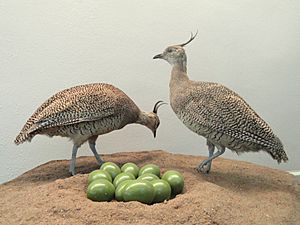
All tinamous belong to the bird family called Tinamidae. They are also part of a larger group of birds known as ratites. Other ratites include ostriches and emus. Unlike most ratites, tinamous can fly, even though they are not strong flyers. Scientists believe that tinamous are the closest living relatives to ancient flying birds from which all ratites evolved.
The first person to identify the elegant crested tinamou was Isidore Geoffroy Saint-Hilaire. He described it in 1832 from a bird found in South America. There are several different types, or subspecies, of the elegant crested tinamou, each living in slightly different areas.
Are They in Danger?
Even though people hunt the elegant crested tinamou for food and sport, it is not considered a rare bird. It lives across a very large area, about 1,400,000 square kilometers (540,000 square miles).
Because of this, the IUCN Red List of Threatened Species lists it as a species of Least Concern. This means it is not currently in danger of disappearing. Some animals that hunt them include skunks, foxes, wild cats, and birds of prey like the red-backed hawk.
See also
 In Spanish: Martineta copetona para niños
In Spanish: Martineta copetona para niños



